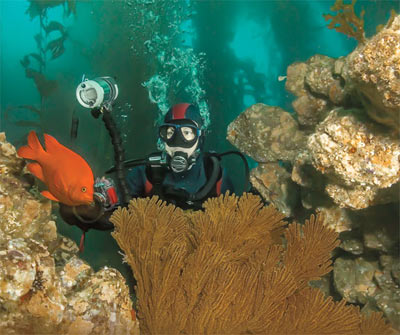After diving California waters for nearly three decades I am amazed how resilient our local oceans can be. Humans and nature deliver blow after blow and she comes back, often quite strong. The recent El Niño is an example. A few years ago it was difficult to find any kelp beds on the south coast; now they are thick and extensive.
The ocean can even recover from the onslaught of man, if properly managed, or just plain left alone. Giant Black Sea Bass have made a remarkable recovery, simply because their take was made illegal. And we may even have just barely saved the abalone. Here and there abalone are beginning to reappear in kelp forests, a positive sign but still decades from full recovery and that is only if left completely alone.
Even so, there are fish and fish stocks that are in serious trouble. And action is needed RIGHT NOW. Like the abalone, if action is taken immediately, we may get the barn door closed before the last horses are lost.
How are we to do this? There are two controversial movements now afoot that directly concern divers and need your input. We must do our part in conservation, both in input on public policy and in cutting back and making sacrifices.
The population of rockfish and lingcod has crashed in the last few years, forcing the California Department of Fish and to impose various emergency closures. Proposals are before the Fish and Game commission to close all nearshore areas (within three miles of shore) to all commercial activities, but open to the sport take of fish. This proposal is generally supported by divers and sportfishers as it will have little effect on their activities.
In a separate proposal, the Channel Islands National Marine Sanctuary is having serious discussions about closing as much as 50 percent of the islands to both commercial and sport fishing. This proposal is generating a higher level of controversy, dividing the sport diving community.
While we all know that commercial fishing takes by far the largest amount of fish and does the most damage, we, too, must make sacrifices and do our part for conservation. To ask commercial fishers to abandon access to an area, and to make it exclusively our own, is not fair, right, or even effective.
The solution that has proven effective in other areas of the world is a harvest refugia. If just 20 percent of coast and island nearshore areas are closed to both commercial and sport take of any kind, the propagation of marine life from these areas is enough to stock the remaining 80 percent, if managed properly. A marine life refuge of this type currently make up less than 1 percent of our nearshore waters.
Key to any conservation plan is the ability to enforce the plan. Harvest refugia is easy to enforce. It’s simple: nobody can take anything in the protected areas — no bag limits, seasons, permits — no excuses. The only issue is movement from a non-refuge area to a refuge area after fish has been taken and even that is generally easy to enforce by observation of vessel movements.
A big advantage of marine life refuges is the establishment of baseline studies. Because humankind has been fishing California waters so heavily for so many years, we really don’t have a good idea as to what a healthy, untouched reef is supposed to look like. If a section of ocean is left alone for a number of years, we can get a good view of that important picture and then be better prepared to make educated decisions on proper fisheries management.
The most controversial issue of marine life refuges is just where to put them. Everybody has their favorite fishing spot, commercial and sport. Scientists are probably in the best position to determine these locations choosing areas that get a mixture of habitats, currents and marine life. Input from commercial and sport services and consumers are, however, critical.
Closing 50 percent of the Channel Islands National Park is unrealistic, unnecessary, and unfair. Shutting out the commercial fishing fleet to all nearshore waters, while keeping these same waters open to spearfishers and sport fishers, is selfish and ultimately will not fly politically. But setting aside large areas, 20 percent total as marine life refuges, is enforceable. It still allows all parties concerned to continue the activities they wish to pursue, including scientists, and has been proven in other areas to work for conservation and a sustainable resource.
Make your voice heard. Decisions are being made now that will affect you. Below are some critical government officials to e-mail: The National Ocean and Atmospheric Administration (NOAA, managers of the Channel Islands and Monterey Bay National Marine Sanctuaries): and the California Department of Fish and Game.










